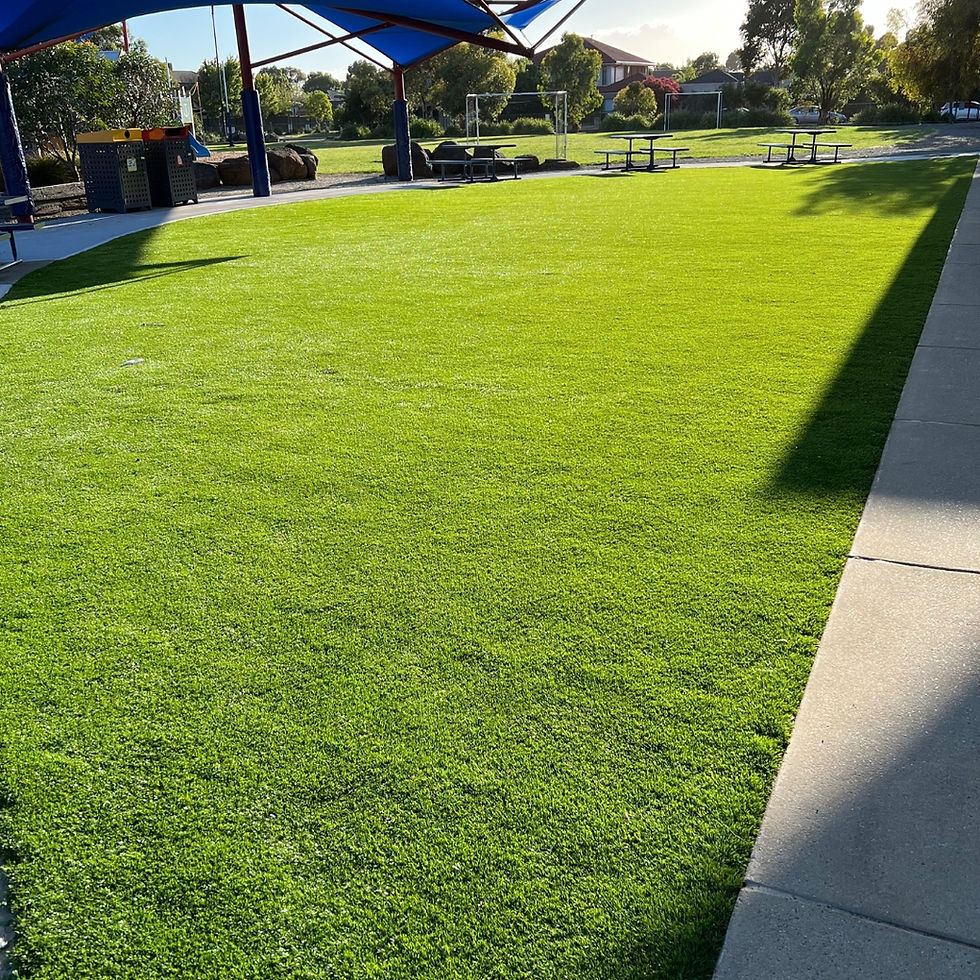Enhancing Child Safety in Play Areas with Artificial Grass Solutions
- Sporting Courts Australia

- Aug 20
- 4 min read
Creating a safe environment for children to play is a top priority for parents, caregivers, and facility managers alike. Child safety in play areas not only promotes healthy physical activity but also contributes to overall well-being and development. One of the effective solutions to ensure safety in these spaces is the incorporation of artificial grass, especially in fall height areas. This article explores the various benefits of using artificial grass in playgrounds and childcare facilities, particularly regarding fall height safety.
Improved Shock Absorption
One of the primary advantages of artificial grass is its ability to absorb shock better than traditional playground surfaces like concrete or natural grass. When kids climb, jump, or play, falls can happen, and having a cushioned surface is crucial in preventing injuries.
Artificial grass designed for playgrounds often features a layered structure that includes shock-absorbing materials underneath. These layers are specifically engineered to minimize the impact during falls, significantly reducing the risk of head injuries and fractures.
By implementing artificial grass in fall height areas, playgrounds can enhance their safety ratings, reassuring parents that their children can play freely without undue risk.
Consistent Surface Quality
Natural grass can suffer from wear and tear due to heavy foot traffic, weather conditions, or improper maintenance. This can lead to uneven surfaces, muddy patches, or bare spots that can become hazardous for children playing on them.
With artificial grass, facilities benefit from a consistent and uniform surface. This not only enhances visual appeal but also ensures that children play in a safe environment without distractions from uneven patches or obstacles.
The maintenance of artificial grass is also minimal compared to natural grass, allowing play areas to always remain in optimal condition, further elevating safety standards.
All-Weather Durability
One of the significant challenges for outdoor play areas is dealing with various weather conditions. Rain, snow, and even intense sunlight can create hazardous situations for children who play outside.
Artificial grass is designed to be durable and resistant to different weather elements. It dries faster than natural grass, reducing the opportunity for slippery surfaces post-rain. This contributes to fall height safety, as wet surfaces can lead to increased fall risks and injuries.
Additionally, artificial grass maintains its vibrant color and texture over time, unlike natural grass that can wilt and brown under harsh conditions, allowing continuous safe play throughout the year.
Reduced Maintenance Costs
Traditional playground surfaces require considerable maintenance, including mowing, fertilisation, aeration, and reseeding. This often results in significant time and financial investment.
With artificial grass, the maintenance needs are drastically reduced. There is no need for mowing or watering, nor concerns about pests or weeds often found in natural grass settings.
This reduction in upkeep not only saves money but also allows staff and caregivers to focus more on supervising children and engaging them in fun activities rather than worrying about maintaining the play area’s conditions.
Environmentally Friendly Options
Modern artificial grass options have become increasingly eco-friendly, making them a suitable choice for environmentally conscious facilities. Many products are now made from recycled materials, reducing overall landfill waste.
Moreover, artificial grass does not require chemicals for maintenance (like pesticides or herbicides) making it a safer option for children and the environment.
Facilities that choose to implement sustainable practices can also encourage children to appreciate eco-friendly play areas, fostering early environmental awareness and responsibility.
Enhanced Aesthetic Appeal
Play areas that utilize artificial grass can transform the environment into a visually appealing landscape. The vibrant green color remains consistent year-round, providing a cheerful backdrop for play.
An attractive play area not only encourages children to engage in physical activity but also serves to attract families. This can be especially beneficial for childcare facilities and parks aiming to foster community involvement.
Additionally, the aesthetic benefits of artificial grass can enhance the neighborhood's overall look, contributing positively to community pride and local engagement.
Promoting Active Play
With the added safety and comfort provided by artificial grass, children are more likely to engage in active play, boosting their physical fitness and social skills. Studies have shown that children who have access to safer play areas tend to spend more time playing outdoors.
As physical activity becomes increasingly critical in combating childhood obesity and related health issues, providing safe and inviting play areas ensures children can enjoy their time outdoors to the fullest.
Conclusion
The benefits of implementing artificial grass in fall height areas cannot be overstated. From improved shock absorption and durability to reduced maintenance and environmental impact, artificial grass presents a compelling solution for enhancing child safety in play areas.
By investing in this innovative landscaping option, parents, caregivers, and facility managers can create a safer, more enjoyable environment for children to thrive. Prioritizing child safety today translates to happier, healthier children tomorrow.
As communities continue to evolve, ensuring that our play areas meet the safety and aesthetic needs of our children is essential. Artificial grass solutions are not only versatile but also an excellent long-term investment in the safety and well-being of future generations.




Comments